Myth or Fact: Colour Changing Eye Drops
Myth or Fact: Colour Changing Eye Drops
You’ve seen them all over Instagram— Social media influencers are promoting sponsored posts about eye drops that promise to change your eye colour from brown to blue with absolutely no side effects! But is it too good to be true? Experts are skeptical. In this infographic, we’ll discuss how eye colour is determined, the FDA approval status of the ingredients in these drops, what they claim, and why they’re unlikely to work as advertised.
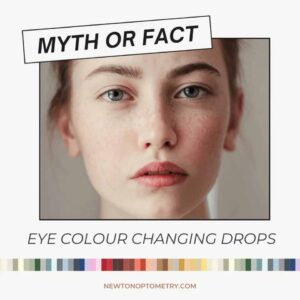
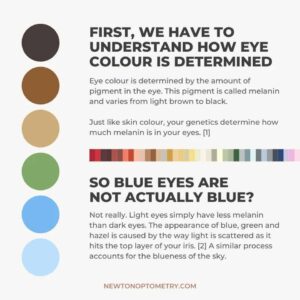
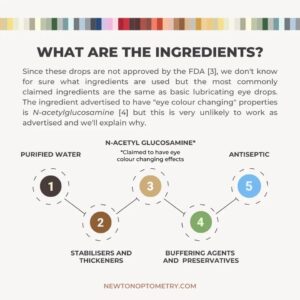
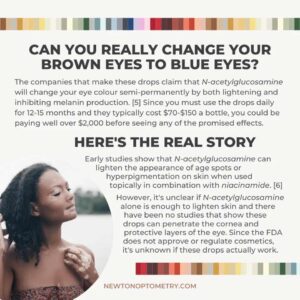
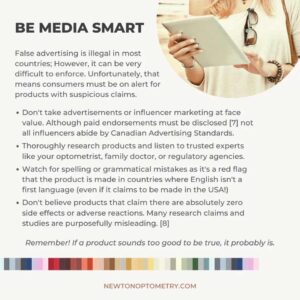
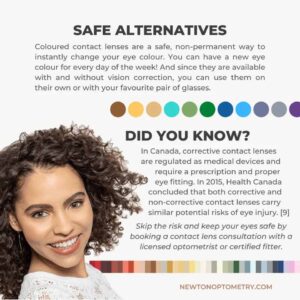
First, we have to understand how eye colour is determined
Eye colour is determined by the amount of pigment in the eye. This pigment is called melanin and varies from light brown to black. Just like skin colour, your genetics determine how much melanin is in your eyes. [1]
So blue eyes are not actually blue?
Not really. Light eyes simply have less melanin than dark eyes. The appearance of blue, green and hazel is caused by the way light is scattered as it hits the top layer of your iris. [2] A similar process accounts for the blueness of the sky.
What are the ingredients?
Since these drops are not approved by the FDA [3] we don’t know for sure what ingredients are used but the most commonly claimed ingredients are the same as basic lubricating eye drops. The ingredient advertised to have “eye colour changing” properties is N-acetylglucosamine [4] but this is very unlikely to work as advertised and we’ll explain why.
Can you really change your brown eyes to blue eyes?
The companies that make these drops claim that N-acetylglucosamine will change your eye colour semi-permanently by both lightening and inhibiting melanin production. [5] Since you must use the drops daily for 12-15 months and they typically cost $70-$150 a bottle, you could be paying well over $2,000 before seeing any of the promised effects.
Here’s the real story
Early studies show that N-acetylglucosamine can lighten the appearance of age spots or hyperpigmentation on skin when used topically in combination with niacinamide. [6] However, it’s unclear if N-acetylglucosamine alone is enough to lighten skin and there have been no studies that show these drops can penetrate the cornea and protective layers of the eye. Since the FDA does not approve or regulate cosmetics, it’s unknown if these drops actually work.
Be media smart
False advertising is illegal in most countries; However, it can be very difficult to enforce. Unfortunately, that means consumers must be on alert for products with suspicious claims.
Don’t take advertisements or influencer marketing at face value. Although paid endorsements must be disclosed [7] not all influencers abide by Canadian Advertising Standards.
Thoroughly research products and listen to trusted experts like your optometrist, family doctor, or regulatory agencies.
Watch for spelling or grammatical mistakes as it’s a red flag that the product is made in countries where English isn’t a first language (even if it claims to be made in the USA!)
Don’t believe products that claim there are absolutely zero side effects or adverse reactions. Many research claims and studies are purposefully misleading. [8]
Remember! If a product sounds too good to be true, it probably is.
Safe Alternatives
Coloured contact lenses are a safe, non-permanent way to instantly change your eye colour. You can have a new eye colour for every day of the week! And since they are available with and without vision correction, you can use them on their own or with your favourite pair of glasses.
Did You Know?
In Canada, corrective contact lenses are regulated as medical devices and require a prescription and proper eye fitting. In 2015, Health Canada concluded that both corrective and non-corrective contact lenses carry similar potential risks of eye injury. [9]
Skip the risk and keep your eyes safe by booking a contact lens consultation with a licensed optometrist or certified fitter.
Still Have Questions About Colour-Changing Eye Drops?
We’re here for you. Whether you have already used these drops and would like to know if they affected the health of your eyes or you’re interested in discussing safe alternatives like coloured contact lenses, our team of optometrists are happy to answer your questions. We believe that maintaining good eye health is an ongoing partnership between patient and doctor which is why we encourage patients (and caregivers) to ask questions and share health information.
We enjoy working collaboratively with our patients and educating them on their eye health in a comfortable, courteous and professional environment. We invite you to learn more about our doctors, or contact us today to get started.


